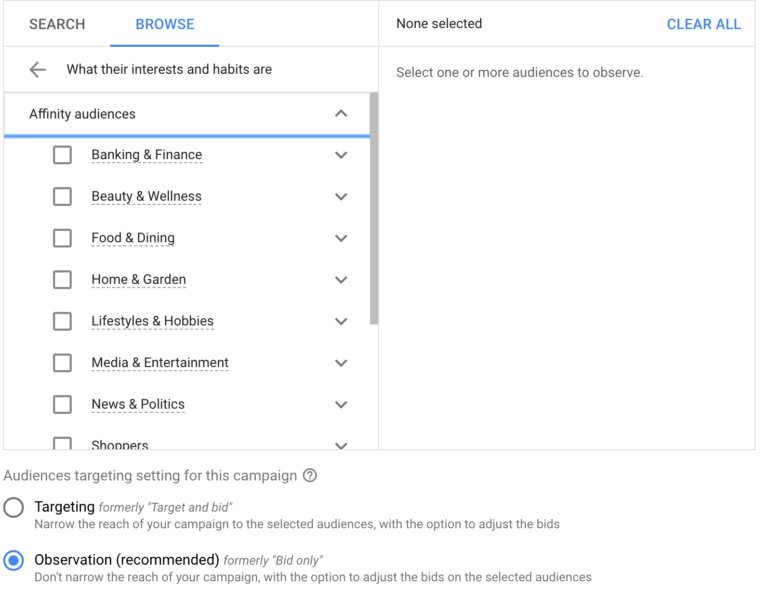11 tips for using Google Ads’ new audiences like a pro
Learn how to reach your ideal customer with Google Ads' new audience types for Search ads.
Google introduced audiences to Search ads over seven years ago with the creation of RLSA. A whole bunch of improvements have happened since then. If you want to be at the cutting edge of using audiences, you need to familiarize yourself with the latest additions to Google’s audience portfolio, which will be coming at the end of this month to all advertisers.
Get to know your new audiences
In case you missed the announcement, here’s a quick recap of Google’s new audience types:
Affinity audiences
You’ve probably at least dabbled with affinity audiences in a display campaign here or there. The news is that they’re now available for search campaigns. These audiences are based on consumer habits and real-life interests.
With these affinity audiences, you can connect someone’s search intent with their passions. If you already know somebody is passionate about what you have to offer, you can properly value their enthusiasm. It’s not only that they’re searching, it’s that they’re searching for something they’re excited about and already into.
Over 132 segments are available across 12 categories.

Seasonal events
Although technically part of the in-market audiences family, seasonal events are about those who are bought into specific buying seasons. Some people aren’t really into Black Friday shopping. Some people really, really are. Seasonal events give you a way to reach the people that care deeply about shopping for Mother’s Day or certain components of back-to-school shopping. And seeing that we’re firmly in pumpkin spice season, you know that audiences for Christmas shopping will be heating up soon. These audiences are also now available for YouTube.
Similar audiences for Customer Match
I’ve heard from plenty of marketers that they like re-engaging with customers via Customer Match. But what about campaigns intended to reach entirely new prospects? Google Ads audiences like the new ones above can work great in these situations, but there’s another new audience type worth mentioning: similar audiences. Similar audiences will now be created for Customer Match lists when possible. You can add these similar audiences to reach people who share similar characteristics to your Customer Match audiences (based on a number of factors, like search behavior).
(And a quick note: The recent announcement didn’t call out this new type of audience, but it’s new and cool enough that it’s worth talking about.)
Use your new audiences like a pro
When you start applying these new audiences to your search campaigns, Google’s guidance often mirrors how you’ve long been using your audiences. That said, there are some specific things to keep in mind as you use the new audience types:
All audiences (up to and including these new ones)
1. Start the planning process by taking a look at Google Ads Audience insights. You can find out all sorts of information about who you’re already reaching, or who you might be better at reaching.
2. Apply audiences with the “Observation” setting as a start. Add the audiences you think you might care about, then let the metrics roll in. This is a quick step, but an important one.
3. Start with the most relevant audiences first. Certain segments are only impactful for audiences and campaigns with high volume for your brand. Start with two to three of the most impactful ones, and only expand once you’ve shown them to be effective.
4. Apply audiences at the campaign level. You can apply at the ad-group level if you have specific reasons, but for most people campaign level should give you the coverage you’re looking for.
5. [If using Smart Bidding, which I heartily recommend] Don’t worry about bid adjustments. Those types of signals are already incorporated into your auction-time bids.
6. [If not using Smart Bidding, which I do not heartily recommend] Adjust bids based on performance differences. Even if an audience seems more or less valuable, let performance dictate. And your bid modifiers might need to be more significant than you are accustomed to. Think +50%, not +5%. You want to make an actual impact.
Affinity audiences
7. Keep an open mind. Affinity audiences can be deployed by certain types of industries that may have written off audience targeting. Health care, financial and religiously-affiliated advertisers, and plenty of others, can use affinity audiences.
Seasonal events (and other in-market audiences)
8. Plan for shifts in audience size. It stands to reason that big Black Friday shoppers aren’t going to be super active in late spring. Audience insights (mentioned in #1) can help give you a sense of relative audience size throughout the year.
Similar audiences for Customer Match
9. Apply your original Customer Match list (we call that the seed list), even if only for reporting. You can get insights from that list alongside the scale of similar audiences.
10. Think long term. Customer Match includes longer term signals, and you surely think of your customers in the long term as well. These similar audiences are based on longer-term, potentially higher value signals, exactly like your best customers.
11. Refresh your seed list regularly. Your Customer Match audiences don’t have an expiration date by default, so it’s possible there might be members that you aren’t interested in reaching anymore. Refreshing your list helps you create similar audiences that are most like your recent, high-quality customers.
Conclusion
Audiences are a powerful way to improve search campaign performance. The two new audience types releasing over the next few weeks (and similar audiences for Customer Match) were designed to improve the reach and relevance of your ads. When you combine those audiences with a customer’s search intent, you have a very effective strategy indeed.
Opinions expressed in this article are those of the guest author and not necessarily Search Engine Land. Staff authors are listed here.
Related stories